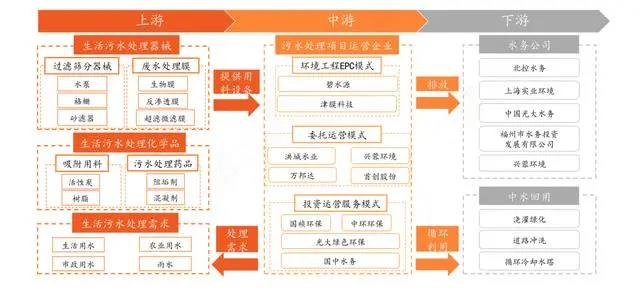Sewage treatment: a fast-growing field of environmental protection and water affairs
- Categories:Industry Information
- Author:
- Origin:
- Time of issue:2021-04-07
- Views:0
(Summary description)
Sewage treatment has been a key area of my country’s ecological environment protection in recent years. The "14th Five-Year Plan" for key river basin water ecological environment protection work promotion meeting put forward "If there is a river, there must be water, if there is water, there must be fish, and if there is fish, there must be grass. , Can swim in the river” requirements.
The "14th Five-Year Plan" will pay more attention to water ecological protection and restoration based on the improvement of water environment quality. Upgrading and upgrading is still the key work of the industry.
In May 2020, the National Development and Reform Commission clearly promoted the utilization of wastewater resources, studied and promoted the drafting of guidelines and related implementation plans for the utilization of wastewater resources, and promoted the establishment of a "1+N" policy framework system for the utilization of wastewater resources.
With the introduction of a series of favorable policies for the industry, the sewage treatment industry is expected to open up the space for rapid growth.
Sewage treatment is an important part of the environmental protection water sector. It refers to the process of removing or reducing solid pollutants and organic pollutants in different types of sewage through professional treatment methods, so that the purified water can meet the requirements for reuse or discharge.
At present, sewage treatment has been widely used in agriculture, petrochemical, medical, catering and other fields.
Sewage treatment is located at the end of the entire water service industry and plays a vital role in the recycling of the water service industry. Only the good operation of the wastewater treatment stage can ensure the continuous circulation of the industrial chain.
At present, my country's sewage treatment industry chain mainly consists of water treatment equipment, engineering construction, and operation services. The proportion of revenue in terms of revenue shows a pyramidal distribution, but in terms of gross profit margin, the further downstream, the higher the gross profit margin.
Sewage treatment industry panorama:
(Chart source: Ping An Securities)
Sewage can be divided into production sewage, domestic sewage and polluted rainwater according to its source.
Production sewage can be divided into industrial sewage, agricultural sewage and medical sewage, of which industrial sewage is the main one. At present, the treatment of industrial sewage and domestic sewage in the production sewage is the key target of the sewage treatment industry.
Although the amount of industrial wastewater discharge has decreased in recent years, the total amount is still high. The top 4 industries with wastewater discharge volume are paper and paper products, chemical raw materials and chemical products manufacturing, textiles, coal mining and washing. In the selection of industries, the wastewater discharge of the four industries was 8.8 billion tons, accounting for 47.1% of the total wastewater discharge of industrial enterprises.
Industrial wastewater is a technology-based industry due to its wide variety, large discharge volume, and many pollutant elements. It requires high technical level of sewage treatment plants, and the treatment processes of different industries are very different.
Rural sewage treatment is still in its infancy, and treatment facilities are generally imperfect in the construction of plant networks. The sewage treatment rate in rural areas is only about 10%. A large amount of untreated rural sewage is directly discharged into the river system and becomes the main source of water pollution.
The key to solving the dilemma of rural sewage treatment is to explore technologies that are high-efficiency, low-input, and low-operating costs, which are suitable for decentralized rural sewage treatment.
At present, there are about 30 kinds of sewage treatment processes in China, and the top six sewage treatment processes are: oxidation ditch process, A2/O process, traditional activated sludge process, SBR process, A/O process and biological Membrane process.
From the perspective of the development history of biological wastewater treatment, the biofilm method was born before the activated sludge method. Although the early biofilm method has the characteristics of high biomass, good purification effect and low energy consumption compared with the activated sludge method, Due to its low hydraulic load and organic load, its application in large-scale sewage treatment projects is limited.
Therefore, currently domestic sewage treatment plants mostly use the activated sludge method and its derivative processes, such as: A2O process, SBR process, oxidation ditch process, AO process, etc.
According to the forecast of China Water Network, the scale of my country's reclaimed water is expected to reach 85 million cubic meters per day in 2025. The total investment in the constru
Sewage treatment: a fast-growing field of environmental protection and water affairs
(Summary description)
Sewage treatment has been a key area of my country’s ecological environment protection in recent years. The "14th Five-Year Plan" for key river basin water ecological environment protection work promotion meeting put forward "If there is a river, there must be water, if there is water, there must be fish, and if there is fish, there must be grass. , Can swim in the river” requirements.
The "14th Five-Year Plan" will pay more attention to water ecological protection and restoration based on the improvement of water environment quality. Upgrading and upgrading is still the key work of the industry.
In May 2020, the National Development and Reform Commission clearly promoted the utilization of wastewater resources, studied and promoted the drafting of guidelines and related implementation plans for the utilization of wastewater resources, and promoted the establishment of a "1+N" policy framework system for the utilization of wastewater resources.
With the introduction of a series of favorable policies for the industry, the sewage treatment industry is expected to open up the space for rapid growth.
Sewage treatment is an important part of the environmental protection water sector. It refers to the process of removing or reducing solid pollutants and organic pollutants in different types of sewage through professional treatment methods, so that the purified water can meet the requirements for reuse or discharge.
At present, sewage treatment has been widely used in agriculture, petrochemical, medical, catering and other fields.
Sewage treatment is located at the end of the entire water service industry and plays a vital role in the recycling of the water service industry. Only the good operation of the wastewater treatment stage can ensure the continuous circulation of the industrial chain.
At present, my country's sewage treatment industry chain mainly consists of water treatment equipment, engineering construction, and operation services. The proportion of revenue in terms of revenue shows a pyramidal distribution, but in terms of gross profit margin, the further downstream, the higher the gross profit margin.
Sewage treatment industry panorama:
(Chart source: Ping An Securities)
Sewage can be divided into production sewage, domestic sewage and polluted rainwater according to its source.
Production sewage can be divided into industrial sewage, agricultural sewage and medical sewage, of which industrial sewage is the main one. At present, the treatment of industrial sewage and domestic sewage in the production sewage is the key target of the sewage treatment industry.
Although the amount of industrial wastewater discharge has decreased in recent years, the total amount is still high. The top 4 industries with wastewater discharge volume are paper and paper products, chemical raw materials and chemical products manufacturing, textiles, coal mining and washing. In the selection of industries, the wastewater discharge of the four industries was 8.8 billion tons, accounting for 47.1% of the total wastewater discharge of industrial enterprises.
Industrial wastewater is a technology-based industry due to its wide variety, large discharge volume, and many pollutant elements. It requires high technical level of sewage treatment plants, and the treatment processes of different industries are very different.
Rural sewage treatment is still in its infancy, and treatment facilities are generally imperfect in the construction of plant networks. The sewage treatment rate in rural areas is only about 10%. A large amount of untreated rural sewage is directly discharged into the river system and becomes the main source of water pollution.
The key to solving the dilemma of rural sewage treatment is to explore technologies that are high-efficiency, low-input, and low-operating costs, which are suitable for decentralized rural sewage treatment.
At present, there are about 30 kinds of sewage treatment processes in China, and the top six sewage treatment processes are: oxidation ditch process, A2/O process, traditional activated sludge process, SBR process, A/O process and biological Membrane process.
From the perspective of the development history of biological wastewater treatment, the biofilm method was born before the activated sludge method. Although the early biofilm method has the characteristics of high biomass, good purification effect and low energy consumption compared with the activated sludge method, Due to its low hydraulic load and organic load, its application in large-scale sewage treatment projects is limited.
Therefore, currently domestic sewage treatment plants mostly use the activated sludge method and its derivative processes, such as: A2O process, SBR process, oxidation ditch process, AO process, etc.
According to the forecast of China Water Network, the scale of my country's reclaimed water is expected to reach 85 million cubic meters per day in 2025. The total investment in the constru
- Categories:Industry Information
- Author:
- Origin:
- Time of issue:2021-04-07
- Views:0
Sewage treatment has been a key area of my country’s ecological environment protection in recent years. The "14th Five-Year Plan" for key river basin water ecological environment protection work promotion meeting put forward "If there is a river, there must be water, if there is water, there must be fish, and if there is fish, there must be grass. , Can swim in the river” requirements.
The "14th Five-Year Plan" will pay more attention to water ecological protection and restoration based on the improvement of water environment quality. Upgrading and upgrading is still the key work of the industry.
In May 2020, the National Development and Reform Commission clearly promoted the utilization of wastewater resources, studied and promoted the drafting of guidelines and related implementation plans for the utilization of wastewater resources, and promoted the establishment of a "1+N" policy framework system for the utilization of wastewater resources.
With the introduction of a series of favorable policies for the industry, the sewage treatment industry is expected to open up the space for rapid growth.
Sewage treatment is an important part of the environmental protection water sector. It refers to the process of removing or reducing solid pollutants and organic pollutants in different types of sewage through professional treatment methods, so that the purified water can meet the requirements for reuse or discharge.
At present, sewage treatment has been widely used in agriculture, petrochemical, medical, catering and other fields.
Sewage treatment is located at the end of the entire water service industry and plays a vital role in the recycling of the water service industry. Only the good operation of the wastewater treatment stage can ensure the continuous circulation of the industrial chain.
At present, my country's sewage treatment industry chain mainly consists of water treatment equipment, engineering construction, and operation services. The proportion of revenue in terms of revenue shows a pyramidal distribution, but in terms of gross profit margin, the further downstream, the higher the gross profit margin.

Sewage treatment industry panorama:
(Chart source: Ping An Securities)
Sewage can be divided into production sewage, domestic sewage and polluted rainwater according to its source.
Production sewage can be divided into industrial sewage, agricultural sewage and medical sewage, of which industrial sewage is the main one. At present, the treatment of industrial sewage and domestic sewage in the production sewage is the key target of the sewage treatment industry.
Although the amount of industrial wastewater discharge has decreased in recent years, the total amount is still high. The top 4 industries with wastewater discharge volume are paper and paper products, chemical raw materials and chemical products manufacturing, textiles, coal mining and washing. In the selection of industries, the wastewater discharge of the four industries was 8.8 billion tons, accounting for 47.1% of the total wastewater discharge of industrial enterprises.
Industrial wastewater is a technology-based industry due to its wide variety, large discharge volume, and many pollutant elements. It requires high technical level of sewage treatment plants, and the treatment processes of different industries are very different.
Rural sewage treatment is still in its infancy, and treatment facilities are generally imperfect in the construction of plant networks. The sewage treatment rate in rural areas is only about 10%. A large amount of untreated rural sewage is directly discharged into the river system and becomes the main source of water pollution.
The key to solving the dilemma of rural sewage treatment is to explore technologies that are high-efficiency, low-input, and low-operating costs, which are suitable for decentralized rural sewage treatment.
At present, there are about 30 kinds of sewage treatment processes in China, and the top six sewage treatment processes are: oxidation ditch process, A2/O process, traditional activated sludge process, SBR process, A/O process and biological Membrane process.
From the perspective of the development history of biological wastewater treatment, the biofilm method was born before the activated sludge method. Although the early biofilm method has the characteristics of high biomass, good purification effect and low energy consumption compared with the activated sludge method, Due to its low hydraulic load and organic load, its application in large-scale sewage treatment projects is limited.
Therefore, currently domestic sewage treatment plants mostly use the activated sludge method and its derivative processes, such as: A2O process, SBR process, oxidation ditch process, AO process, etc.
According to the forecast of China Water Network, the scale of my country's reclaimed water is expected to reach 85 million cubic meters per day in 2025. The total investment in the construction of reclaimed water utilization facilities-membrane technology is expected to be 1,055-211.0 billion in 2021-2025.
Water treatment technology continues to innovate. Some technologies have more advantages than traditional activated sludge methods in terms of effluent quality, investment cost, operation management, applicability, etc., and will have more applications in the future for upgrading and upgrading and recycling of wastewater. space.
Companies that involve new processes such as MBR, MBBR, BAF and related membrane materials and water treatment agents involved in the upgrading and transformation will benefit.
Environmental protection is of great significance in the economic and social transformation of our country.
With the development of my country's economy, the importance of effective use of energy, reduction of environmental pollution, reduction of the frequency of safety production accidents, prevention of sudden environmental incidents, and safety of life has become increasingly prominent.
As of the end of September 2020, there are 88 A-share listed environmental protection companies with a total scale of 588.48 billion yuan, accounting for 1.02% of the total A-share market value. They are an important backbone force in the development of my country's environmental protection industry.
Ping An Securities believes that with the upgrading and transformation of sewage treatment plants and the advancement of sewage recycling, membrane technology that can realize advanced biological sewage treatment has strong applicability in the future. Major companies in this field include Bishuiyuan, Sanda Membrane, and Jinke Environment, etc.
The upgrading and transformation of existing sewage treatment plants have high requirements on investment, floor space, treatment efficiency, and operating costs. The new technology with low cost and high efficiency is expected to be favored by the market. Major companies in this field include Jindal, etc. .
During the "14th Five-Year Plan" period and in the future, the amount of sludge produced will maintain an upward trend. The national policy orientation will push up the demand for the harmless disposal and resource utilization of sludge, and "anaerobic digestion/aerobic fermentation + land use" and The "dry incineration" technology has a better effect on the "four modernizations" of sludge. This type of company and front-end sludge treatment equipment companies will benefit, such as recleaning environmental protection and related solid waste companies that mix sludge.
A number of measures are expected to improve the current financial difficulties of enterprises in the environmental protection industry. Under the background of continuous deepening of policies, increased financial support, and improvement of the financing environment, the environmental protection segment will also return to the high-growth business cycle.
The "14th Five-Year Plan" upgrade investment space is about 80 billion yuan. The state encourages industrial production, urban greening, road cleaning, vehicle washing, construction and ecological landscape to give priority to the use of recycled water. The sewage treatment industry is expected to open up the space for rapid growth.
Scan the QR code to read on your phone
Copyright © 2021 Shandong SINOUN Electric Co., Ltd. All rights reserved
鲁ICP备2021038506号-1 国际站建设:中企动力 淄博 外贸谷歌推广






What can I help you?

sdzldq@126.com

No. 19, Wangxu Road, North District, Economic Development Zone, Huantai, Zibo, Shandong



